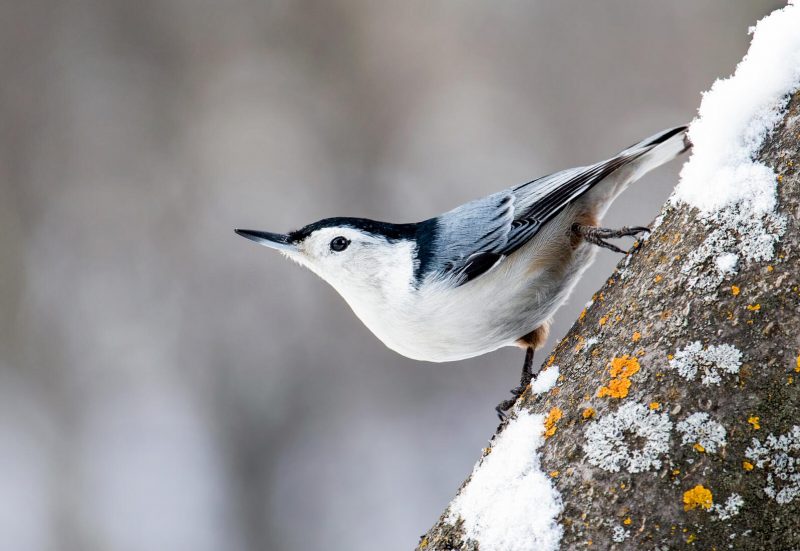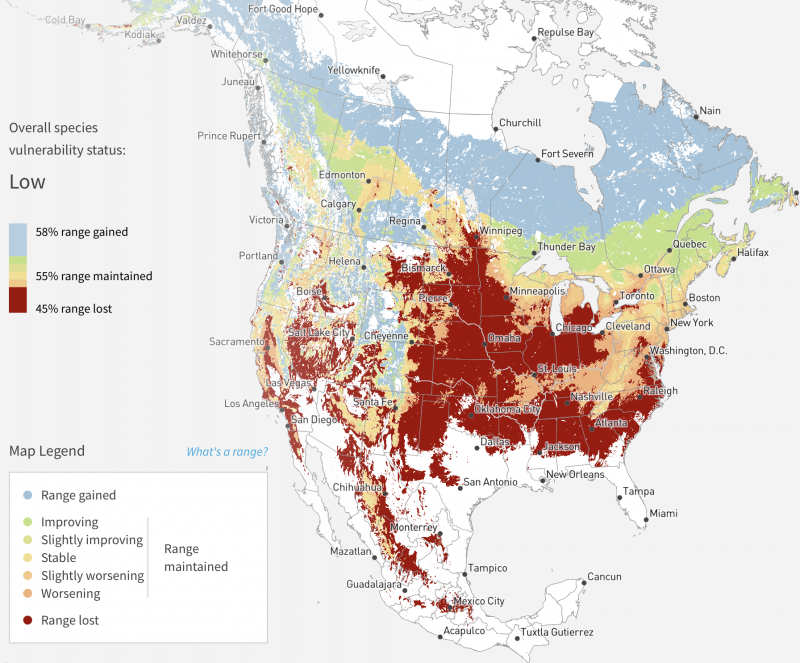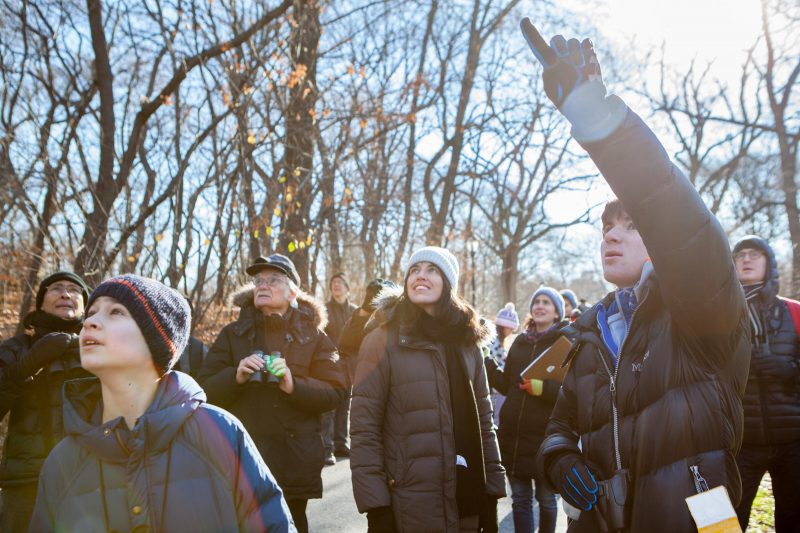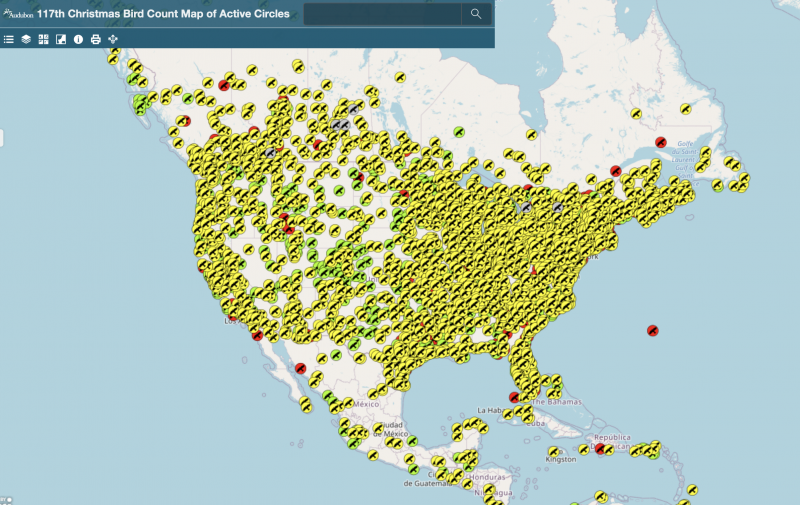
Bird ranges move north as climate warms
On January 25, 2022 the National Audubon Society in New York announced a newly published study of birds in the eastern United States. The study is based on 90 years of data from citizen scientists who participated over decades in Audubon’s Christmas Bird Count. It shows a response from these birds to climate change and habitat availability.
The researchers sorted 89 species of eastern U.S. birds into groups. All groups of birds were seen responding to climate-related changes in temperature and precipitation, as these factors affected their winter ranges. For example, large forest birds and woodpeckers are now wintering farther north than before.
EarthSky 2022 lunar calendars now available! Order now. Going fast!
90 years of data
This was the first time that Audubon scientists had analyzed up to 90 years of Christmas Bird Count data. The researchers determined that the winter ranges of all the birds they studied have moved in response to climate change. They also found that bird species with specific habitat needs (e.g. grasslands or wetlands) are even more restricted by habitat availability. That is, whether a habitat can meet their basic needs and that climate change alters the picture for that as well.
The peer-reviewed journal Global Change Biology published the new study on January 21. The study’s lead author is Sarah Saunders, who is a quantitative ecologist at Audubon. In other words, she uses mathematical and statistical tools to study birds. She commented in a statement:
Birds tell us that climate change is already having an effect on them, but not all birds are equally vulnerable to climate change. If we want to give birds the best chance at survival, habitat conservation needs to be part of our efforts to fight climate change. We can still secure a future for birds and people, but the science is clear: we need to act on climate now.

Christmas Bird Count data
This study was possible only because the Aububon scientists had access to more than 90 years of Christmas Bird Count observations. The Audubon Christmas Bird Counts have been happening every year since the year 1900. Audubon describe the count as “an early-winter bird census,” taking place each year from December 14 through January 5. Indeed, it involves thousands of volunteers across the U.S., Canada and other countries in the Western Hemisphere.
During the Christmas Bird Count, the volunteers go out over a 24-hour period on one calendar day to count birds.
The Audubon researchers used data from 119 different count circles in the eastern United States. They sorted 89 species of birds into the following groups: large forest birds, forest passerines, grassland birds, mixed-habitat birds and waterbirds. Additional groups also include shrubland birds, waterfowl, wetland passerines and woodpeckers.
The researchers commented that habitat-restricted birds like waterfowl, wetland birds and grassland birds are also responding to climate change:
They are only spending the winter where there is suitable habitat remaining.

Audubon’s Christmas Bird Count told by Chan Robbins from Audubon Science on Vimeo.
What birds need now
Marshall Johnson, chief conservation officer for Audubon, said:
This study confirms that protecting birds from climate change in the future needs to go hand-in-hand with protecting healthy natural spaces that birds need right now.
A statement from Audubon said that climate change threatens more than two-thirds of North America’s bird species with extinction. That figure comes from Audubon’s 2019 report Survival By Degrees: 389 Species on the Brink. But, Audubon said, the same science:
…suggests that by limiting global warming to 1.5 degrees Celsius, more than three-quarters of vulnerable species can be protected. [That is why] Audubon supports efforts to reach net-zero carbon pollution by 2050.
Geoff LeBaron, director of Audubon’s Christmas Bird Count, said:
This important new study is just the latest example of peer-reviewed research made possible by more than 12 decades’ worth of Christmas Bird Count data. Every bird tallied (or not) tells us a little more about the state of our environment, and we are grateful to all Christmas Bird Count participants and compilers who help us protect birds and the places they need, today and tomorrow.
In addition to the Christmas Bird Count, Audubon invites members and supporters to participate in its Great Backyard Bird Count, to be held February 18 to 21, 2022.

Bottom line: A new study from the National Audubon Society uses 90 years of Christmas Bird Count data. It shows the ranges of eastern United States birds shifting northward.
Read more about the White-breasted Nuthatch
The post Bird ranges shifting northward: Audubon study first appeared on EarthSky.
from EarthSky https://ift.tt/3u5S85Y

Bird ranges move north as climate warms
On January 25, 2022 the National Audubon Society in New York announced a newly published study of birds in the eastern United States. The study is based on 90 years of data from citizen scientists who participated over decades in Audubon’s Christmas Bird Count. It shows a response from these birds to climate change and habitat availability.
The researchers sorted 89 species of eastern U.S. birds into groups. All groups of birds were seen responding to climate-related changes in temperature and precipitation, as these factors affected their winter ranges. For example, large forest birds and woodpeckers are now wintering farther north than before.
EarthSky 2022 lunar calendars now available! Order now. Going fast!
90 years of data
This was the first time that Audubon scientists had analyzed up to 90 years of Christmas Bird Count data. The researchers determined that the winter ranges of all the birds they studied have moved in response to climate change. They also found that bird species with specific habitat needs (e.g. grasslands or wetlands) are even more restricted by habitat availability. That is, whether a habitat can meet their basic needs and that climate change alters the picture for that as well.
The peer-reviewed journal Global Change Biology published the new study on January 21. The study’s lead author is Sarah Saunders, who is a quantitative ecologist at Audubon. In other words, she uses mathematical and statistical tools to study birds. She commented in a statement:
Birds tell us that climate change is already having an effect on them, but not all birds are equally vulnerable to climate change. If we want to give birds the best chance at survival, habitat conservation needs to be part of our efforts to fight climate change. We can still secure a future for birds and people, but the science is clear: we need to act on climate now.

Christmas Bird Count data
This study was possible only because the Aububon scientists had access to more than 90 years of Christmas Bird Count observations. The Audubon Christmas Bird Counts have been happening every year since the year 1900. Audubon describe the count as “an early-winter bird census,” taking place each year from December 14 through January 5. Indeed, it involves thousands of volunteers across the U.S., Canada and other countries in the Western Hemisphere.
During the Christmas Bird Count, the volunteers go out over a 24-hour period on one calendar day to count birds.
The Audubon researchers used data from 119 different count circles in the eastern United States. They sorted 89 species of birds into the following groups: large forest birds, forest passerines, grassland birds, mixed-habitat birds and waterbirds. Additional groups also include shrubland birds, waterfowl, wetland passerines and woodpeckers.
The researchers commented that habitat-restricted birds like waterfowl, wetland birds and grassland birds are also responding to climate change:
They are only spending the winter where there is suitable habitat remaining.

Audubon’s Christmas Bird Count told by Chan Robbins from Audubon Science on Vimeo.
What birds need now
Marshall Johnson, chief conservation officer for Audubon, said:
This study confirms that protecting birds from climate change in the future needs to go hand-in-hand with protecting healthy natural spaces that birds need right now.
A statement from Audubon said that climate change threatens more than two-thirds of North America’s bird species with extinction. That figure comes from Audubon’s 2019 report Survival By Degrees: 389 Species on the Brink. But, Audubon said, the same science:
…suggests that by limiting global warming to 1.5 degrees Celsius, more than three-quarters of vulnerable species can be protected. [That is why] Audubon supports efforts to reach net-zero carbon pollution by 2050.
Geoff LeBaron, director of Audubon’s Christmas Bird Count, said:
This important new study is just the latest example of peer-reviewed research made possible by more than 12 decades’ worth of Christmas Bird Count data. Every bird tallied (or not) tells us a little more about the state of our environment, and we are grateful to all Christmas Bird Count participants and compilers who help us protect birds and the places they need, today and tomorrow.
In addition to the Christmas Bird Count, Audubon invites members and supporters to participate in its Great Backyard Bird Count, to be held February 18 to 21, 2022.

Bottom line: A new study from the National Audubon Society uses 90 years of Christmas Bird Count data. It shows the ranges of eastern United States birds shifting northward.
Read more about the White-breasted Nuthatch
The post Bird ranges shifting northward: Audubon study first appeared on EarthSky.
from EarthSky https://ift.tt/3u5S85Y

Aucun commentaire:
Enregistrer un commentaire